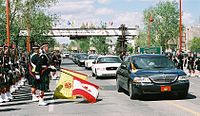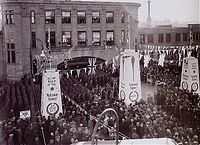- Military in Calgary
-
Beginning with establishment of Fort Calgary (a North-West Mounted Police fort) in 1875, the city of Calgary, Alberta, has had some degree of permanent military presence throughout its history.
Contents
First World War
 Members of CEF battalions who trained near Signal Hill left a visible mark on the city at Battalion Park
Members of CEF battalions who trained near Signal Hill left a visible mark on the city at Battalion Park
Calgary has had an active military garrison since the early years of the 20th Century. Strathcona's Horse had one squadron quartered in the city for many years. A local militia regiment was finally raised after several attempts by Lieutenant Colonel William C.G. Armstrong, when the 103rd Regiment "Calgary Rifles" was authorized on 1 April 1910. Units of the artillery, engineers and supporting corps also had units in Calgary from time to time. In 1914, several battalions of the Canadian Expeditionary Force were raised in Calgary, notably the 10th and 50th. Training took place at nearby Sarcee Camp, which grew enormously during the First World War. The camp later became known as Sarcee Training Area. Nearby Battalion Park overlooks this area. In 1920–21, the Canadian military was reorganized, and the 103rd Regiment was split into two separate regiments, and by 1939 these were known as The Calgary Highlanders and the Calgary Regiment (Tank). Other supporting units remained in the city as well. By 1939, these included the 15th Alberta Light Horse, 19th Field Brigade, Royal Canadian Artillery, (including component subunits 23rd (Howitzer) Battery, 91st Battery, and 95th Battery), 13th Field Company, Royal Canadian Engineers, No. 13 District Signals, and No. 9 Construction Section.
 Sarcee Camp in 1915. Public Archives of Canada photo.
Sarcee Camp in 1915. Public Archives of Canada photo.Second World War
In 1939, many Calgary raised units joined the Canadian Active Service Force overseas. The Calgary Highlanders mobilized on 1 September 1939 and joined the 2nd Canadian Infantry Division, moving to Shilo, Manitoba in the summer of 1940 on the way to overseas employment. A 2nd Battalion was raised and served as a part-time Militia unit throughout the war. The Highlanders returned to Calgary on 24 November 1945 to a warm welcome, along with the 23rd Anti-Tank Battery (a component of the 2nd Anti-Tank Regiment) and the 91st Field Battery, Royal Canadian Artillery. The Calgary Regiment (Tank) mobilized in 1941 and eventually served in 1st Canadian Army Tank Brigade (later 1st Canadian Armoured Brigade), most famously serving at Dieppe but later being reconstituted and fighting in Sicily, Italy, and North-West Europe. A reserve unit remained in Calgary. As well, a contingent of the Alberta University Canadian Officers Training Corps was located in the city.
 HM Queen Elizabeth II passes a Guard of Honour of the Calgary Highlanders, to whom she has been appointed Colonel-in-Chief, during the Royal Visit of May 2005. The Queen of Canada took the opportunity to inspect both her Calgary regiments on the occasion of Alberta's Centennial.
HM Queen Elizabeth II passes a Guard of Honour of the Calgary Highlanders, to whom she has been appointed Colonel-in-Chief, during the Royal Visit of May 2005. The Queen of Canada took the opportunity to inspect both her Calgary regiments on the occasion of Alberta's Centennial.
By the end of the Second World War, a greatly enlarged Regular Force saw a sizable military garrison located in Calgary, and regular battalions of the PPCLI and Queen's Own Rifles, as well as Lord Strathcona's Horse (Royal Canadians) were quartered in the city. In 1995, the Regular Force garrison - including the Strathcona's, 1 PPCLI, 1 Service Battalion, 1 MP Platoon, and the headquarters of Land Force Western Area as well as 1st Canadian Brigade Group all moved to Edmonton, leaving a skeleton staff of regular personnel in Calgary to administer the local Militia units.
Permanent military facilities were completed in 1917 with the construction of Mewata Armouries, which then housed reserve units and a squadron of regular cavalry. Currie Barracks became an important training base during the Second World War, and many British Commonwealth Air Training Plan facilities were located in and around the city, including what is today the Southern Alberta Institute of Technology. Currie Barracks, and nearby Harvey Barracks, were both developed after the war to form Canadian Forces Base Calgary (CFB Calgary). A second armoury was built in a Northeast Calgary industrial park in the 1980s. Harvey Barracks (and the adjacent Sarcee Training Area) were returned to the Tsuu T'ina Nation after the lease expired, and CFB Calgary was closed. Only the headquarters for a reserve brigade and a small Area Support Unit remain.
Despite the closing of CFB Calgary (including both Currie Barracks and Harvey Barracks), the city is still home to a significant military presence of Naval and Army Reserve units including:
- HMCS Tecumseh, a Naval Reserve unit, and HMCS Tecumseh Band at the HMCS Tecumseh Building located at 1820 24 Street SW
Army Reserve units, with their training locations in brackets include:
- Headquarters, 41 Canadian Brigade Group (former CFB Calgary)
- The King's Own Calgary Regiment (RCAC) (Mewata Armoury)
- Regimental Band of The King's Own Calgary Regiment (RCAC) (The Military Museums)
- 41 Combat Engineer Regiment (Northeast Armoury)
- 746 (Calgary) Communication Squadron (HMCS Tecumseh building)
- The Calgary Highlanders (Mewata Armoury)
- Regimental Pipes and Drums of The Calgary Highlanders (Mewata Armoury)
- 14 (Calgary) Service Battalion (Northeast Armoury)
- 15 (Edmonton) Field Ambulance - Calgary Detachment (Canadian Forces Health Services Group) (Northeast Armoury) [1]
- Militia Training Detachment Calgary (Mewata Armoury)
Additionally, there are several squadrons of the Royal Canadian Sea Cadets, Navy League Cadets, Royal Canadian Army Cadets, and Royal Canadian Air Cadets who train at various facilities.
Notable Calgarians in the Canadian military
- Ian Bazalgette - awarded a posthumous Victoria Cross in 1944 for actions as a Bomber Command pilot of the Royal Canadian Air Force.
- Robert Hampton Gray, Royal Canadian Naval Volunteer Reserve at HMCS Tecumseh, the only person in the Canadian Navy and the last Canadian to be awarded the Victoria Cross.
- John George Pattison - awarded the Victoria Cross for actions with the 50th Battalion, Canadian Expeditionary Force at Vimy Ridge in 1917.
- R.B. Bennett - Prime Minister of Canada and also long-time Honorary Colonel of The Calgary Highlanders.
- Douglas Harkness - commander of an anti-tank battery of the Royal Canadian Artillery in the Second World War, and later Minister of National Defence.
- Mark Tennant - rose from the rank of private in 1939 to major with the Calgary Highlanders during the Second World War and later served several terms as an Alderman of the City of Calgary.
See also
- CFB Calgary
- RCAF Station Calgary
- The Military Museums
- Calgary Soldiers' Memorial
References
Categories:- History of Calgary
- Military history of Canada
Wikimedia Foundation. 2010.

